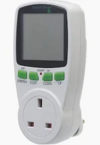There is a small problem with high power users (over 2 kW) which run for an extended time, the fuse produces heat, and the plug can some times over heat, so an immersion heater will either use a 15 amp plug and socket which has no fuse in it, or a fused connection unit, the 15 amp plug was popular in the 50's as it resulted in the plumber could fit a new immersion heater without touching wiring, but today plumbers don't seem to worry about doing electrical work, so that idea seems to have gone.
The appendix to the regulations says
The load current in any part of the circuit should be unlikely to exceed for long periods the current-carrying capacity of the cable (Regulation 433.1.5 refers). This can generally be achieved by:
(i) locating socket-outlets to provide reasonable sharing of the load around the ring
(ii) not supplying immersion heaters, comprehensive electric space heating or loads of a similar profile frog the ring circuit
(iii) connecting cookers, ovens and hobs with a rated power exceeding 2 kW on their own dedicated radial circuit
(iv) taking account of the total floor area being served. (Historically, limit of 100 m² has been adopted.)
this is not the actual regulation but again over 2 kW. In theroy over 18 Kg with no wheels and it is not portable, but in real terms only immersion heater and tumble drier resistive type run for long enough to be a problem, most other equipment even if over 2 kW has some thermostat or timer, so the time it draws over 2 kW is very low, or it is over 3 kW so can't use a 13 amp plug anyway.
To be able to use something like this

or this
it needs to be a plug and socket, so much easier with a plug and socket arrangement.
Before the RCD we did have boilers and the like with a FCU so the earth could be bonded, but that is well in the past. although my boiler uses a FCU and is the only item in the house not RCD protected.


